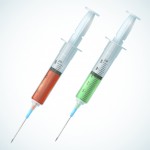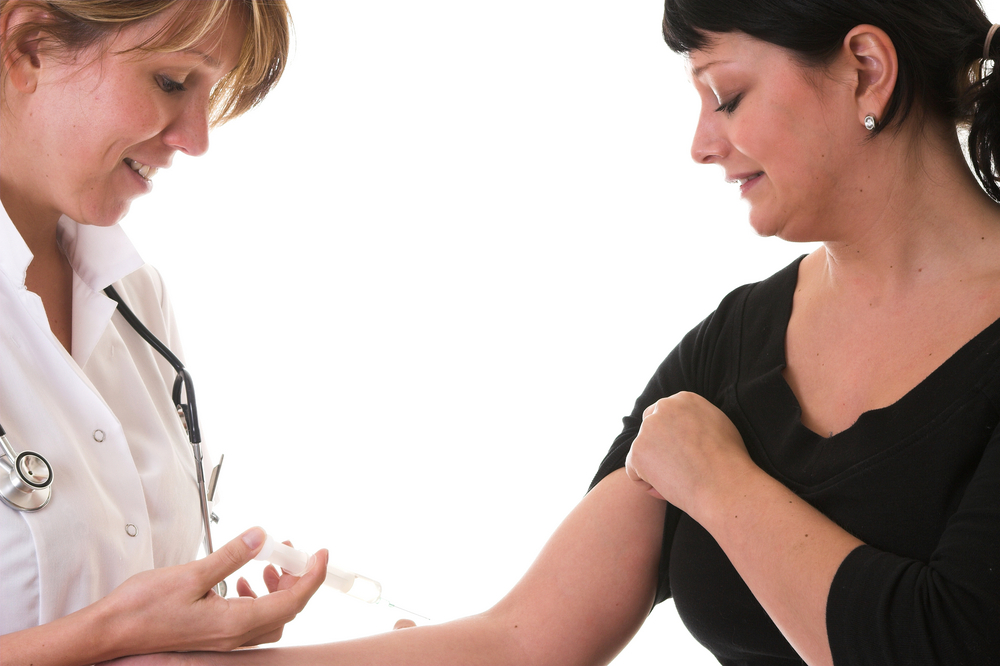
Antipsychotic non-adherence rates are reported to be as high as 75% by some studies (Byerly et al, 2007). Though side effects are often the main reason for this, cognitive impairment and chaotic lives also made it harder for patients to take the tablets which can provide them some symptomatic benefit.
Depot (long-acting injectable) medications can be a solution to some of these problems. They are administered at intervals of weeks or months and neither the care team nor the patient have to worry about missed doses. The evidence is hazy but some studies suggest that depots could actually work better than tablets too (Goff, 2014).
Some of the older ‘typical’ antipsychotics have been around in depot form for decades, but since 2003 several of the newer ‘atypical’ antipsychotics have been marketed in long-acting injectable form as well. Risperidone was the first, but it needs to be given every two weeks and has to be kept refrigerated. Paliperidone palmitate, a metabolite of Risperidone, followed in 2009 with significant fanfare due to a supposed relative lack of side effects. It could also be given in monthly doses and didn’t need to be kept cool, but a price-tag of $1,000 per injection made it far from perfect.
At $35 per injection, the older Haloperidol decanoate depot is far cheaper, so it would be worthwhile knowing how it measures up to the flashy new kid on the block, Paliperidone, in terms of side effects and symptom benefit. Fortunately, a recent RCT in JAMA examines just this question.

Depot injections can make life easier for patients who worry about missing their doses
Methods
ACLAIMS (A Comparison of Long-acting Injectable Medications for Schizophrenia) was a between-groups, double blind, randomised clinical trial conducted over 22 sites in the US.
The inclusion criteria were:
- Aged 18-65
- Diagnosis of schizophrenia or schizoaffective disorder by DSM-IV-TR criteria
- Judged as likely to benefit from a depot by their psychiatrist and the study psychiatrist
- Judged as being at risk of efficacy failure due to previous non-adherence to medication or substance abuse
- Able to provide informed consent
The exclusion criteria were:
- Stable and well on their current antipsychotic
- Reason to believe they might not do well on the depot (i.e. past experience)
- Moderate or severe tardive dyskinesia
- Intellectual disability
- Medical illness that might preclude safe participation in the study
- Pregnancy or breastfeeding
Patients were enrolled into one of two groups:
- Paliperidone palmitate long-acting injections
- 234 mg on day 1
- 156 mg on day 8
- then 117 mg monthly
- Haloperidol decanoate long-acting injections
- 50 mg on day 1
- 50 mg on day 8
- 75 mg on day 28
- then 50 mg monthly
Patients went through an initial trial phase of 4 to 7 days during which they took the oral equivalent of their medication to ensure they would not react aversely to it.
Benztropine was available to both groups if extra-pyramidal side effects occurred.
Patients were given their first injection 4 to 7 days into a trial phase and were then reviewed at 1, 2, 4, 6, 8, 10, and 12 weeks and then monthly for 2 years.
The treating clinicians were blind to which drug was being given; they wrote prescriptions for both. If they felt treatment should continue despite certain risks (new onset diabetes, weight gain, high LDL cholesterol, tardive dyskinesia, admission to hospital, deterioration on the CGI), permission from a safety officer had to be sought.
Outcomes
The primary outcome was:
- Efficacy failure (determined by the majority decision of an outcome adjudication committee of 3 blinded research psychiatrists, using criteria like the need for admission, the need for crisis resolution, an increase in outpatient appointment frequency, and the need for additional oral medication).
The secondary outcomes were:
- Worst change from baseline in weight
- Worst change from baseline in blood glucose, HbA1c, LCL cholesterol and triglycerides on blood tests at 3, 6 then every 6 months
- Highest prolactin concentration
- Scores of akathisia, parkinsonism, abnormal movements and sexual functioning
- Positive and negative symptoms scale (PANSS)
Only patients who had at least one injection and underwent at least one set of post-baseline measures were included in the primary analysis, as a modified intention-to-treat population.
Results
311 of the 353 patients assessed for eligibility were assigned to one of the two groups (154 for Paliperdone vs 157 for Haloperidol). 147 patients in each group received at least one injection, but 2 from each group did not attend for their first set of post-baseline measures, so 145 from each group were included in the primary analysis.
Similar numbers of patients discontinued treatment in each group (104 in the Paliperidone group vs 101 in the Haloperidol group) due largely to participant decision, inadequate therapeutic effect or adverse effects. 68 patients prematurely withdrew from the Paliperidone arm of the trial and 62 from the Haloperidol group due largely to withdrawing consent or being lost to follow-up.
There were no obvious differences between the two groups at baseline in terms of age (43 vs 45 years), gender, illness type or severity (schizophrenia in 71 vs 73% of cases), physical health or previous antipsychotic treatment (age of first antipsychotic prescription 26 vs 27 years old).
The mean doses in the first month were 325 mg for Paliperidone and 94 mg for Haloperidol. Subsequently the mean monthly doses were 129-169 mg for Paliperidone and 67-83 mg for Haloperidol.
There was no statistically significant difference in terms of the primary outcome measure, efficacy failure (33.8% for Paliperidone versus 32.4% for Haloperidol). The most common reasons for failure were readmission to hospital and clinician discontinuation due to inadequate therapeutic effect.

The authors found no significant difference in the rate of efficacy failure for patients on paliperidone vs haloperidol
Decreases in PANSS scores were similar in both groups at each timepoint (at 6 months for example, -6.87 vs -6.40).
Paliperidone led to weight gain (average 2.17 kg over 6 months) and Haloperidol to weight loss (average -0.96 kg over 6 months) with a significant difference between the two (p=<0.0001).
There were no statistically significant differences between the two groups in terms of HbA1c, glucose, cholesterol or triglycerides. Neither was there a difference concerning rates of tardive dyskinesia or abnormal involuntary movements.
Akathisia was more common in the Haloperidol group (2.8 vs 10.6% of patients had a BAS score >3, p=0.006) and more patients in this group took medication for it (3.6 vs 11.0%, p=0.03). There was no significant difference in ratings of parkinsonism between the groups, but the patients in the Haloperidol group took more medication for these symptoms (15.8 vs 29.3%, p=0.007).
Prolactin levels were significantly higher in the Paliperidone group in both men (34.56 ug vs 15.41 ug, p=<0.001) and women (75.19 ug vs 26.84 ug, p=<0.001).
Rates of sialorrhea were significantly higher in the Paliperidone group (16.3 vs 10.9%), the only subjectively reported side effect with more than 5% difference between the groups.
Discussion
This relatively large and pragmatic study provides firm evidence that the newer antipsychotic, Paliperidone, is no better at preventing relapse or controlling psychotic symptoms than its decades-old comparator, Haloperidol.
Predictably, the drugs do differ in their side effect profiles. Paliperidone leads to weight gain and higher prolactin levels (but not, in this study, more diabetes or other metabolic derangements). Haloperidol leads to more akathisia and use of other drugs to control parkinsonism.
This is further evidence for the practice of choosing an antipsychotic based on the least risky side-effect profile for a particular patient. The far higher price tag of Paliperidone ($1,000 vs $35 per injection) should be a strong influence on the clinical decision too.

Paliperidone is >28 times more expensive than Haloperidol
Limitations
The usual critiques of an antipsychotic RCT apply to this paper:
- Potential unblinding due to differing rates of certain side effects
- Non-specificity of outcomes scales like PANSS
- A biased cohort of chronically unwell patients who are willing to consent to take part
- A biased group of participating doctors who put their patients forward
- A high drop-out rate
- There was no oral antipsychotic comparator group, and though a placebo control group would have been unrealistic to demand, one does wonder just how much difference antipsychotics make to patients who have been ill so long and relapse so often.
Also, the persistent use of such hard surrogate endpoints (readmission, crisis) for treatment failure underestimates the complexity of psychotic illnesses and the patients who suffer from them. We should be more subtle in our measurements of a treatment being unsuccessful and not consign people to having ‘failed’ after one blip. There were no measures of patient experience or satisfaction, which is a dismaying oversight. Patient preference is one of the most important measures for any treatment we offer.
In addition, the primary outcome measure of “efficacy failure” as judged by a blinded panel of psychiatrists seems highly subjective and nebulous.
Finally, I personally believe that without adequate social and psychological care, it doesn’t matter what antipsychotic you put your patient on – they’re going to relapse and every drug will look similarly mediocre. We shouldn’t forget that when we obsess over prescription options.
Links
McEvoy JP, Byerly M, Hamer RM, Dominik R, Swartz MS, Rosenheck RA, Ray N, Lamberti JS, Buckley PF, Wilkins TM, Stroup ST. Effectiveness of Paliperidone Palmitate vs Haloperidol Decanoate for Maintenance Treatment of Schizophrenia: A Randomized Clinical Trial. JAMA. 2014;311(19):1978-1986. doi:10.1001/jama.2014.4310. [PubMed abstract]
Byerly MJ, Nakonezny PA, Lescouflair E. Antipsychotic medication adherence in schizophrenia. Psychiatr Clin North Am. 2007 Sep;30(3):437-52. [PubMed abstract]
Goff DC. Maintenance treatment with long-acting injectable antipsychotics: comparing old with new. JAMA. 2014 May 21;311(19):1973-4. doi: 10.1001/jama.2014.4311. [PubMed abstract] quoting Rosenheck RA, Krystal JH, Lew R, et al. Long-acting risperidone and oral antipsychotics in unstable schizophrenia. N Engl J Med.2011;364(13):1281.


RT @Mental_Elf: Paliperidone is no better than Haloperidol at preventing relapse or controlling psychotic symptoms http://t.co/9TVGBjaziV
Paliperidone Palmitate is no better than Haloperidol Decanoate at preventing relapse or controlling psychotic … http://t.co/sPuWU1QZzG
Vivien Kemp liked this on Facebook.
Is it worth spending 28 times as much on Paliperidone Palmitate compared to Haloperidol Decanoate? http://t.co/SqbVoB05ih
Scott Inglis liked this on Facebook.
Today @PsychiatrySHO covers @JAMA_current RCT looking at depot maintenance treatments for schizophrenia http://t.co/SqbVoB05ih
Mental Elf: Paliperidone Palmitate is no better than Haloperidol Decanoate at preventing relapse or controlling… http://t.co/AVGV03tsVI
The Mental Elf liked this on Facebook.
RCT finds no sig diff in the rate of efficacy failure for schizophrenia patients on paliperidone vs haloperidol http://t.co/SqbVoB05ih
Paliperidone Palmitate no better than Haloperidol Decanoate but is a lot more expensive http://t.co/DXydCIa7rX via @sharethis
Christine Spurlock Kim liked this on Facebook.
Don’t miss: Paliperidone is no better than Haloperidol at preventing relapse or controlling psychotic symptoms http://t.co/SqbVoB05ih
@Mental_Elf from practice, the typical antipsychotics are more in use, to good effect, and at least the potential effects are known !
MT @Mental_Elf: Paliperidone is no better than Haloperidol at preventing relapse or controlling psychotic symptoms http://t.co/AwEooDTvvs
Paliperidone Palmitate is no better than Haloperidol Decanoate at preventing relapse o controlling psychotic symptoms http://t.co/u7rkSBBenf
Juliet Shepherd liked this on Facebook.
Carina Kirby liked this on Facebook.
Great piece. I’m currently collecting data on prescribing patterns for consta and paliperidone in the north west. The evidence base is looking similar for consta, the most rigorous trial being this one. http://journals.psychiatryonline.org/article.aspx?volume=168&page=603
What are your thoughts on this paper which suggests Paliperidone is better than zuclopenthixol both for schizophrenia patients w/ substance abuse relapsing back on illicit drugs and in terms of their PANSS score. I’m surprised this wasn’t mentioned in the McEvoy paper.
http://www.ncbi.nlm.nih.gov/pubmed/16933590
Carina Kirby liked this on Facebook.
Juliet Shepherd liked this on Facebook.
Christine Spurlock Kim liked this on Facebook.
The Mental Elf liked this on Facebook.
Scott Inglis liked this on Facebook.
Vivien Kemp liked this on Facebook.